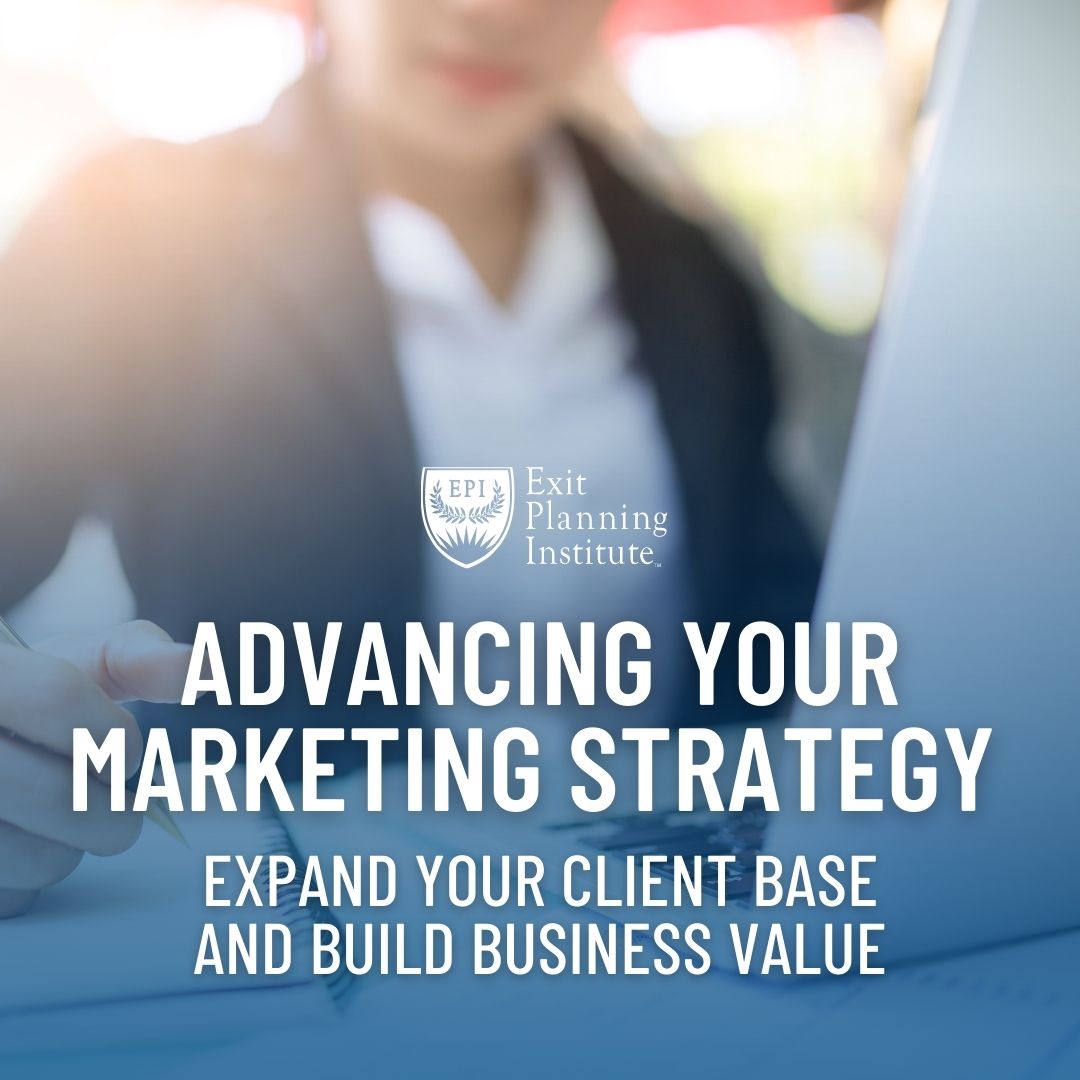
THE EXIT PLANNING BLOG
Keep up-to-date with exit planning, succession planning, industry trends, unique specialty insights, and useful content for professional advisors and business owners.
Share this
9 Marketing Tips for Professional Advisors Looking to Attract Business Owner Clients
by Colleen Kowalski on June 24, 2021

As a professional advisor, you work with business owners on every aspect of their business. But are you engaging with potential new clients in a meaningful way? What does your current marketing strategy look like? Are you sharing content your audience is interested in? Better yet… do you know who your target audience is?
Why is Marketing Important for Professional Advisors?
We surveyed professional advisors and found they want more education around marketing and engaging owners in a more significant business relationship. The only reason a customer buys a product, registers for an experience, or purchases a service is because it is the solution to a problem. And in some cases, it solves a problem they didn’t even know they had. According to Marketing Made Simple: A Step-By-Step Storyboard Guide For Any Business, “Stating the problem is a way to be remembered in your customer’s mind… if you want to be remembered, associate your product or service with the solution to a problem.”
1. Know Your Target Audience & How to Reach Them
Your business is only as valuable as your ability to share your brand story and purpose to the correct audience. How do you ensure that your message is being delivered to the right target market? Do you even know who that “right” target market is and what their pain points include? Your service is not for everyone so your marketing techniques should not try to reach everyone either. Create buyer persona guidelines to ensure all content created will be valuable to your target audience.
Research your current client’s demographics as well as their psychographics or interests to get a complete understanding of their needs. The Harvard Business Review writes, “thoughtful use of psychographics will help you develop not only the messages and campaigns but also the products and services that specific customers want and need.” For example, is your current client base interested in vacations and is nearing retirement? Use this combination of demographics and psychographics to create a marketing campaign highlighting planning for their retirement life including a list of vacation getaways and tours for retirees.
2. Create & Share Valuable Content
Business owners are looking for information on how to improve their business, minimize expenses, and increase their profits. But how do you create content that fills that need without getting lost in the shuffle of thousands of other professional advisors that can offer similar insights?
The key to creating successful content that resonates with potential business owner clients is to share the story of your business and the ways your business can help owners with theirs. This story will inform any potential clients about your brand, products, and ultimately fosters a genuine connection between customers and your company.
Always keep your audience and your strengths in mind. If you’re a terrible writer, maybe blogging isn’t for you. If you’re meant to be a radio host, maybe it’s podcasting. Play to your strengths, but also keep in mind which types of content your audience prefers to consume.
HubSpot shares that “blogging is a great way to generate organic traffic, particularly for those prospects who have not reached a purchasing decision yet. In addition, it can establish credibility in your space and position you as a thought leader.”
When drafting a blog article, ask yourself the following questions:
- Does this education or entertain?
- Is this relevant to my target audience?
If you answer “no” to these questions during your content creation process, it is time to rework the piece into something that benefits the potential client instead of writing a piece just to write the piece.
3. Utilize Social Media to Humanize Your Brand
Social media provides a look into businesses, owners, and advisors on a personal level. Social media is the most effective way to reach new customers, engage with current customers, and share a behind the scenes look at your business. Get the most out of your social networks by sharing insightful messages about your business and your personal life.
According to Investor’s Business Daily, sharing personal stories “has a greater impact than a financial article as people get to know the real you.” As a professional advisor, potential clients are looking for someone they can relate to on a personal level. Owners must feel comfortable trusting you with confidential financial matters.
When in doubt, follow the 80/20 rule when curating your social media content. 80% of all content you post should be entertaining, educational, or solution-based posts. The remaining 20% of your content can be explicitly promotional content for your business, products, or services. Too much self-promotion content comes across as pushy and does not attract, much less engage, potential clients.
EPI’s LinkedIn page highlights industry trends, education for advisors or business owners, and shares EPI team stories. While these posts promote EPI, they do not explicitly promote our Certified Exit Planning Advisor programming or push salesy messaging. Your social media should provide more to your audience than to your business.

4. Follow Brand Guidelines Across All Platforms
Your brand should be easily recognizable within any content you publish and through all marketing efforts. Forbes shares, “a disorganized brand story leaves customers confused and uninterested.” Ensure your branding is consistent across all marketing channels. This is where a brand book comes into play.
A brand book should include, at minimum, the following components:
- Logo – Include all acceptable treatments to the logo and where each can be used.
- Brand Colors – What colors does your brand utilize and how? For example: EPI utilizes two shades of blue as feature colors, green for supplemental imagery, and orange as a CTA color. Include all HEX, CMYK, and Pantone codes for the brand colors.
- Sample Imagery – What style photos does your brand use in marketing? Do you incorporate lifestyle imagery or more corporate looking photos?
- Typography – What fonts do you utilize for Headings, Subheadings, and Body Copy in your marketing materials? Include standards for font size to be used for digital and print media.
In addition to the visuals incorporated into your marketing, your brand voice should be easily recognized in your marketing. There should not be a jarring difference between messaging on your website compared to how you speak on LinkedIn or in print. While each platform offers you a chance to reach your audience in a different way, the message should remain consistent.
5. Rework Successful Existing Content in New Ways
Do you have a piece of content that has performed extremely well? Use it again! Just because an article has been published on a certain topic, it does not mean you wash your hands of that topic and move on.
Well performing content tells us two things:
- This particular topic resonates with your audience.
- Your audience likes to receive content in this form, whether the piece was an article, video, webinar, etc. This method of promotions is successful for your brand.
At Exit Planning Institute, we tend to write a lot about Exit Planning, no surprises there. But if we notice a certain theme, say, how Divorce Impacts Business Owners, is successful, we rework that topic into additional campaigns
There is a fine line between reworking successful content in new ways and beating your audience over the head with the same information over and over. Small Business Chron shared, “Repetition can build brand familiarity, but it can also lead to consumer fatigue, where consumers become so tired that they tune out or actively avoid the product. Therefore, to be effective, repetition must occur in the right proportion, as too much repetition may be counterproductive as an advertising strategy.”
6. Research, Research, Research & Industry Trends
Marketing is an ever-changing and growing field. With new trends emerging on social media daily, something that trends one day may be old news by the following morning. This makes it hard to schedule content too far in advance because by the time it is posted the content may not be trending. We recommend incorporating a mix of trending and evergreen content to fill out your marketing efforts. Evergreen content is not time sensitive and can be published at any time to promote your business.
As a professional advisor, capitalize on trending topics in the business, finance, and exit planning industries. Simply sharing a trending article from a trusted publication or business with your unique take on the findings can be instrumental in driving leads to your business.
7. Cultivate Leads Organically via Email Marketing
Email marketing is one of the most successful marketing techniques, especially for professional businesses. HubSpot shared that 80% of business professionals believe that email marketing increases customer retention. Additionally, 59% of marketers find that email marketing provides their largest ROI. Email marketing can range from a weekly newsletter, promoting upcoming events, and nurturing leads in your sales funnel.
Invest in a CRM system that can automate your emails to different segments of your target audience. This ensures each potential customer is receiving information pertinent to their specific needs. Through this system, you can also analyze the open and click-through rates for your content and can adjust your email strategy, as necessary. 90% of content marketers say email engagement is the top metric they track to measure performance, according to the Content Marketing Institute.
8. Use Search and Social Ads to Increase Brand Awareness and Engagement
Paid Search allows for your business or keywords to appear at the top of search engines for a specific keyword search, regardless of how high your web pages rank in SEO, Search Engine Optimization. Google Ads are the most popular of Paid Search ads due to Google’s large market share. According to HubSpot, “Google Ads is an effective way to drive qualified traffic, or good-fit customers, to your business while they’re searching for products and services like the ones you offer. With Google Ads, you can boost your website traffic, receive more phone calls, and increase your in-store visits.” Paid advertisements on Google account for 65% of all Google clicks. Utilizing Google Ads for your business can offer a great value for your advertising dollar.
Paid Social ads offer a bit more creative freedom for your business. With advertising opportunities across a wide spectrum of social media platforms, you can customize your advertisement to fit the platform and the audience you intend to reach. In contrast to organic posts, Paid Social ads reach members of your target audience who may not be following your content. Around 75% of global marketers invest in social media marketing and 58% of marketers say that social media has helped boost sales. Paid Social ads are relatively inexpensive but have a lower click-through rate than search ads because they are more intrusive to the viewer.
9. Stay Organized with Content Calendars
Content marketing can be extremely overwhelming if you are not organized. Without a set schedule of when blogs, social posts, and emails are to be released, it is almost guaranteed that a piece of content will slip through the cracks. Especially for professional advisors who have a lot of tasks on their plate, organizing your marketing efforts into weekly, monthly, and quarterly content calendars ensures that your content is cohesive and structured.
At EPI, we structure our content calendars in a shareable spreadsheet that is accessible by the entire marketing team. The shareable sheet allows for our team to collaborate on large campaigns that may have content shared on numerous platforms. For example, our EPI Marketing for The Professional Advisors Masterclass has promotions on social media, through email campaigns, mentions on our webinars, and a landing page. Having all this information with scheduled publish dates helps limit confusion for our team.
Are you interested in learning more Top Marketing Tips from industry expert, Kiley Peters? Register for our on-demand EPI Marketing for The Professional Advisors Masterclass.
Our on-demand masterclass can be completed whenever works best for you, so it can easily accommodate your busy schedule. The topics covered include:
Identifying, understanding, and finding your target audience
Building your brand and core differentiators
Creating valuable content that builds your business
Business development tactics and KPIs

Share this
- Blog (545)
- CEPA (422)
- exit planning (249)
- CEPA community (187)
- Business Owner (172)
- Exit Planning Summit (97)
- EPI Chapter Network (89)
- Value Acceleration Methodology (80)
- Exit Planning Partner Network (76)
- EPI Announcement (49)
- Content (48)
- Webinars (37)
- Excellence in Exit Planning Awards (33)
- Marketing (30)
- 2024 Exit Planning Summit (28)
- 5 Stages of Value Maturity (26)
- Books (24)
- EPI Academy (24)
- EPI Team (22)
- Exit Planning Teams (22)
- Leadership (21)
- 2023 Exit Planning Summit (20)
- family business (20)
- women in business (19)
- Intangible Capital (18)
- Exit Options (17)
- Black Friday (16)
- CPA (15)
- Walking to Destiny (15)
- State of Owner Readiness (14)
- Chapters (13)
- Chris Snider (12)
- National Accounts (12)
- Small business (12)
- charitable intent (12)
- personal planning (12)
- Financial Advisors (11)
- Season of Deals (9)
- 5 Ds (8)
- About us (8)
- Podcast (8)
- Insiders Bash (7)
- Scott Snider (7)
- Christmas (6)
- Exit Planning Content Library (6)
- Case Studies (5)
- Owner Roundtables (5)
- Three Legs of the Stool (5)
- Value Advisors (5)
- financial planning (5)
- Awards (4)
- Circle of Excellence (4)
- Exit & Succession (4)
- Five Ds (4)
- executive training (4)
- EPI Thought Leadership Council (3)
- Owners Forum (3)
- author (3)
- forbes (3)
- DriveValue (2)
- Exit Is Now Podcast (2)
- Peter Christman (2)
- Veteran (2)
- Whitepapers (2)
- Business Owners Forum (1)
- SOOR (1)
- business consultants (1)








